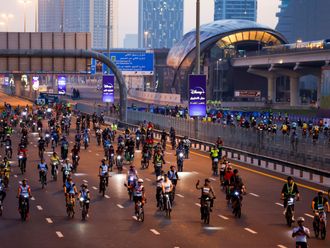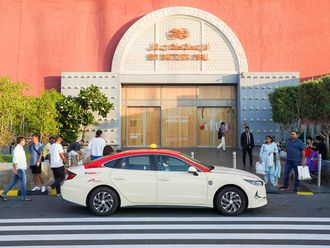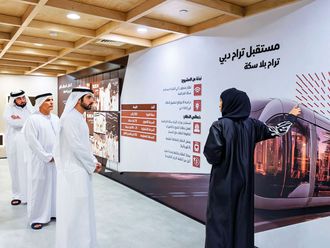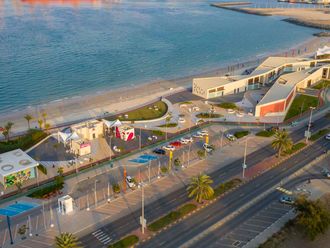Dubai: Dubai's skyline is expanding and climbing higher virtually every day. Wherever you look there is one familiar sight: a crane hanging over the horizon.
According to statistics available, about 125,000 tower cranes are operating worldwide. Industry experts cautiously estimate that 15 to 25 per cent of the world's cranes are here. (See top right for picture gallery)
Patrick Mullaney, Tower Crane Operations Manager for Select Plant Gulf, the heavy machinery arm of Al Naboodah Laing O'Rourke, arrived in Dubai three years ago to work on the new airport site.
On arrival he approached the Guinness Book of World Records to enter Dubai for the high number of cranes on the site at the time. "There were 50 cranes, all over the 12-tonne capacity. It's the most we've had at the site and we are just one contractor. We tried to get it in the Guinness Book of World Records, but they weren't that interested," said Mullaney.
Tower cranes used to build skyscrapers are put up in two days on average. "The tallest free standing crane we used was at Ski Dubai, which measured 92.5 metres," said Mullaney.
The crane at Burj Dubai will eventually be 750 metres above ground level. Laing O'Rourke is currently working on four big projects Dubai airport, Festival city, Burj Dubai and the Old Town and Atlantis hotel on Palm Island.
The construction boom in Dubai is very fast paced due to the overwhelming workforce and building around the clock. "At the most, we as a contractor had about 11,000 men working at the airport. Sites are just flooded with workers," said Mullaney.
"Tower cranes help the whole site. You can't do without them. Mobile cranes are limited because you keep having to move them. Tower cranes can be placed closer together and have a radius of about 140 square metres," he said.
Log book: 'The biggest challenge is to stay focused'
Gurjeet Singh, 45, from India has been a crane operator in Dubai for three years. "I have my high school diploma and a licence for operating both tower and mobile cranes," said Singh, adding that he earns Dh2,500 per month.
"The biggest challenge is to stay focused and watch the crane traffic, to see which is moving towards or away from you. The cabin has air-conditioning and I have a heater so I can make coffee," he said.Would he have taken up the same profession in India? He said If he were still in India he would have gone into agriculture, but doubts that he would be able to provide for his family as he is now.
'The ... fastest pace of construction I have seen in my career'
Willy Cadayong, 54 from the Philippines is a tower crane erecting supervisor. He has been working in the construction industry for 28 years and was transferred to Dubai by his company to work on some of the biggest projects three years ago.
"This is the fastest pace of construction I have seen in my career. Everyday we erect a new crane," said Cadayong. "Our job is risky because we are high up all the time. The highest crane here [in Festival City] is 156 metres high. I'm not scared but until I retire I will be working putting up tower cranes," he added.
Population: They grow in numbers by the hour
The Burj Dubai construction site is peppered with metallic rods and steel structures emerging from the ground. To the untrained eye this could look like the skeletons of a lost city. In fact, it is the birthing place of what will be the world's tallest skyscraper.
The number of tower cranes overlooking the site is breathtaking and when you think you have counted them all, you suddenly see one more.
Tower cranes are the most common cranes in Dubai used for construction and contractors are having to book cranes well in advance, even before projects are finalised in order to be sure to start construction with enough heavy machinery.
So here goes. One, two, three tower cranes. Does a travelling crane count? And the climbing cranes strapped to the Burj Dubai that mount as the tower does? With the sweep of an eye you can already take in close to 30 cranes. Look again and it has doubled.
With a finger outstretched towards the sky to count these birds of Dubai, it is this journalist's estimate that there could be close to 150 cranes from this spot as far as the eye can see.
Count them for yourself but the number might have already increased.
An integral part of construction sites
Cranes come in all shapes and sizes capable of lifting different weights. Tower cranes, mobile cranes and crawler cranes are three main types of the heavy machinery used to lift construction materials.
Mohammad Shadab Khan, senior sales engineer for Kanoo Machinery said cranes are an integral part of a construction site. "Without one you don't have a construction site. They are needed to lift beams or water tanks," he said.
The most common cranes in Dubai are tower cranes which have a lifting capacity of 12 tonnes. The cost of a medium sized crane starts at Dh1 million.
"Operating a crane is a very demanding job. It is a high-tech job because inside the cabin there are about 16 computers to operate. You need to be relatively well educated," said Khan.
Namesake from the avian world
- The common crane is also known as the Eurasian crane. It is over a metre tall, can weigh up to 5.5kg and has a wingspan of 210cm. According to the International Crane Foundation the population is between 250,000 to 275,000 but the species is declining.
- The Eurasian Crane's breeding range extends from northern and western Europe across Eurasia to northern Mongolia, northern China, and eastern Siberia. The winter range includes portions of France and the Iberian Peninsula, north and east Africa, the Middle East, India, and southern and eastern China.
Definition: What is it?
- A crane is a common fixture on construction sites used to lift anything beyond human capacity like steel, concrete blocks, beams, tanks and other types of building materials
- The most commonly used cranes are tower cranes and mobile cranes
Tallest
- Tower cranes are usually the tallest cranes. The base of the crane is bolted onto a large concrete pad. The base connects to the mast (or tower), which gives the tower crane its height. Attached to the top of the mast is the slewing unit the gear and motor that allows the crane to rotate.
- Usual maximum height for a free standing crane is 80 metres. A crane can only go higher if attached to a structure which grows around the crane.
- The maximum reach of a crane is 70 metres.
On the move
- The mobile crane is relatively simple. A telescopic boom (arm) or steel truss mounts its movable platform. Either pulleys or levers raise the boom. Generally a hook suspends from the boom.
- The platform of a mobile crane can either have traditional wheels, wheels designed for railroad tracks, or a caterpillar track, which is useful for navigating unpaved and uneven surfaces. Mobiles can be used for demolition or earthmoving by replacing the hook with an appropriate tool, such as a wrecking ball or bucket.












